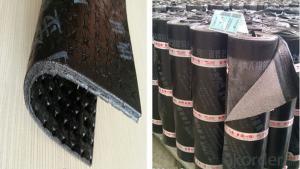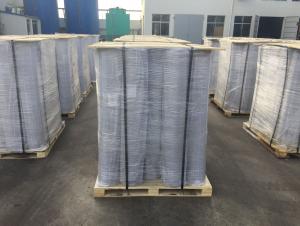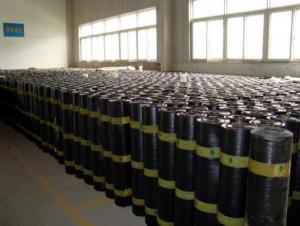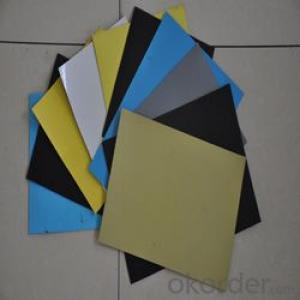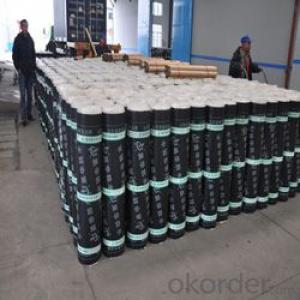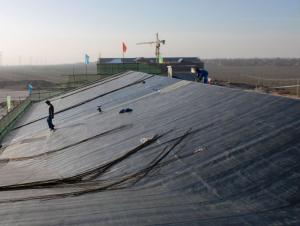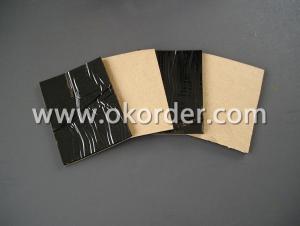SBS-Modified Bitumen Waterproof Membrane with Polyester Fiber and PE Film Type II
- Loading Port:
- Tianjin
- Payment Terms:
- TT OR LC
- Min Order Qty:
- 1000 m²
- Supply Capability:
- 500000 m²/month
OKorder Service Pledge
OKorder Financial Service
You Might Also Like
SBS-PYPE is a waterproofing modified bitumen base sheet consisting of styrene-butadiene-styrene (SBS) modified asphalt reinforced with polyester fiber covering with polyethylene surfacing. There have two kinds of thickness: 3 mm, 4 mm。
We have two kinds of type in our company。They are I type and II type。They have differentt kinds of low temperature flexibility。
This type is 3mm thickness,type II。
If you want to know more about us,call the salesman of CNBM International Corporation (CNBM International) 。
CNBM INTERNATIONAL CORPORATION
Address:17th Floor, NO.4 Building, Zhuyu Business Center, Shouti South Road,Haidian District, Beijing,China
Post Code:100048
Tel:(86-10)68796888
Fax:(86-10) 68796668
Email:marketing@okorder.com, hr@okorder.com
- Q: Can a waterproofing membrane be used in temporary or temporary structures?
- Yes, a waterproofing membrane can be used in temporary or temporary structures. It provides an effective barrier against moisture, protecting the structure from potential water damage during its temporary lifespan.
- Q: Can a waterproofing membrane be used on concrete surfaces?
- Yes, a waterproofing membrane can be used on concrete surfaces. Waterproofing membranes are commonly used to protect concrete structures such as basements, foundations, and roofs from water damage. These membranes are designed to create a barrier that prevents water from penetrating the concrete surface. They can help to prevent moisture buildup, mold, and deterioration of the concrete. Additionally, waterproofing membranes can also provide added protection against chemicals, UV rays, and other environmental factors. It is important to ensure that the membrane is properly installed and compatible with the specific concrete surface to achieve the desired waterproofing results.
- Q: Can a waterproofing membrane be used on precast nickel surfaces?
- Yes, a waterproofing membrane can be used on precast nickel surfaces. The membrane will provide a protective barrier against water penetration, helping to prevent moisture damage and corrosion on the nickel surface.
- Q: Can a waterproofing membrane be used for water fountains or decorative features?
- Yes, a waterproofing membrane can be used for water fountains or decorative features. Waterproofing membranes are designed to provide a protective barrier against water penetration and can be applied to various surfaces, including those used in water fountains and decorative features. These membranes are typically made from materials such as rubber, bitumen, or liquid-applied coatings, which offer excellent waterproofing properties. By applying a waterproofing membrane, you can ensure that water does not seep into the underlying structure and cause damage. This is particularly important for water fountains and decorative features as they involve constant exposure to water. Additionally, waterproofing membranes can also help prevent leaks, cracks, and other potential issues that may arise from water exposure, thus prolonging the lifespan of the fountain or decorative feature.
- Q: Can a waterproofing membrane be applied on top of insulation materials?
- Yes, a waterproofing membrane can be applied on top of insulation materials. However, it is important to ensure that the insulation material is properly installed and does not compromise the effectiveness of the waterproofing system. Additionally, the type of insulation material used should be compatible with the waterproofing membrane to avoid any potential issues or damage.
- Q: Can a waterproofing membrane be used in conjunction with soundproofing materials?
- Using waterproofing membranes in conjunction with soundproofing materials is a common practice in construction projects. Waterproofing membranes are typically employed to prevent water from entering a structure, while soundproofing materials are used to minimize noise transmission. Although these materials serve different purposes, they can be utilized simultaneously to achieve both waterproofing and soundproofing advantages. For instance, in buildings with basements or bathrooms, waterproofing membranes can be installed on the walls or floors to prevent water infiltration. Subsequently, soundproofing materials can be added on top of the membranes to reduce noise transmission from adjacent areas. By combining these two materials, a building can be safeguarded against water damage while also providing a quieter and more comfortable environment for its occupants.
- Q: How does a waterproofing membrane perform in areas with high temperature fluctuations?
- Various environments, including those with high temperature fluctuations, require a waterproofing membrane to act as a protective barrier against moisture infiltration. The performance of the waterproofing membrane in these areas can be influenced by factors such as the material chosen, the installation method, and the specific conditions of the application. To withstand the expansion and contraction that occurs in the substrate during high temperature fluctuations, a high-quality waterproofing membrane must maintain its integrity. It is crucial to consider the material used for the membrane, as certain materials like modified bitumen or thermoplastic olefin (TPO) possess inherent flexibility and durability, enabling them to effectively endure temperature fluctuations. These materials have the capacity to expand and contract without developing cracks or splits, thus ensuring the long-term performance of the waterproofing system. The installation method is also of great importance in guaranteeing the effectiveness of the waterproofing membrane in areas with temperature fluctuations. Proper installation techniques, including appropriate surface preparation, adequate adhesion, and suitable seam sealing, are necessary to establish a continuous and reliable barrier against moisture intrusion. Additionally, the incorporation of expansion joints or movement accommodation details can assist in accommodating thermal movements and preventing stress on the membrane. Maintenance and inspection are essential in identifying any potential issues or damage to the waterproofing membrane caused by temperature fluctuations. Timely repairs or replacements of damaged sections can prevent further deterioration and preserve the functionality of the waterproofing system. To sum up, a well-designed and correctly installed waterproofing membrane can effectively function in areas with high temperature fluctuations. The choice of material, installation techniques, and regular maintenance all play significant roles in ensuring the durability and long-term performance of the waterproofing system in such environments.
- Q: Are waterproofing membranes suitable for balconies and terraces?
- Yes, waterproofing membranes are suitable for balconies and terraces. These membranes are specifically designed to provide a protective barrier against water and moisture, preventing any potential damage to the structure of the balcony or terrace. Waterproofing membranes are typically made of materials such as rubber, bitumen, or PVC, which are highly resistant to water penetration. They are applied as a liquid, sheet, or spray, creating a seamless layer that covers the entire surface of the balcony or terrace. This ensures that no water can seep through and cause any structural issues, such as cracks, leaks, or deterioration. Additionally, waterproofing membranes can also protect against other forms of damage, such as mold growth or corrosion. Overall, using waterproofing membranes on balconies and terraces is an effective and recommended solution for maintaining their longevity and structural integrity.
- Q: Are waterproofing membranes resistant to sewage?
- Yes, waterproofing membranes are resistant to sewage. These membranes are specifically designed and manufactured to provide a barrier against various liquids, including sewage. They are made from durable materials that can withstand exposure to sewage and prevent any leakage or seepage. Waterproofing membranes create a protective layer that keeps sewage from penetrating and damaging the underlying structures. This resistance to sewage makes waterproofing membranes an effective solution for areas prone to sewage backup or high moisture content, such as basements, bathrooms, and water treatment facilities.
- Q: Can a waterproofing membrane be used on precast copper surfaces?
- Yes, a waterproofing membrane can be used on precast copper surfaces. The membrane will create a barrier that prevents water penetration, ensuring the durability and longevity of the copper surface.
Send your message to us
SBS-Modified Bitumen Waterproof Membrane with Polyester Fiber and PE Film Type II
- Loading Port:
- Tianjin
- Payment Terms:
- TT OR LC
- Min Order Qty:
- 1000 m²
- Supply Capability:
- 500000 m²/month
OKorder Service Pledge
OKorder Financial Service
Similar products
Hot products
Hot Searches
Related keywords















